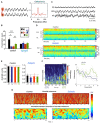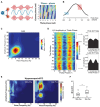Alterations of Coherent Theta and Gamma Network Oscillations as an Early Biomarker of Temporal Lobe Epilepsy and Alzheimer's Disease
- PMID: 30210311
- PMCID: PMC6119809
- DOI: 10.3389/fnint.2018.00036
Alterations of Coherent Theta and Gamma Network Oscillations as an Early Biomarker of Temporal Lobe Epilepsy and Alzheimer's Disease
Abstract
Alzheimer's disease (AD) and temporal lobe epilepsy (TLE) are the most common forms of neurodegenerative disorders characterized by the loss of cells and progressive irreversible alteration of cognitive functions, such as attention and memory. AD may be an important cause of epilepsy in the elderly. Early diagnosis of diseases is very important for their successful treatment. Many efforts have been done for defining new biomarkers of these diseases. Significant advances have been made in the searching of some AD and TLE reliable biomarkers, including cerebrospinal fluid and plasma measurements and glucose positron emission tomography. However, there is a great need for the biomarkers that would reflect changes of brain activity within few milliseconds to obtain information about cognitive disturbances. Successful early detection of AD and TLE requires specific biomarkers capable of distinguishing individuals with the progressing disease from ones with other pathologies that affect cognition. In this article, we review recent evidence suggesting that magnetoencephalographic recordings and coherent analysis coupled with behavioral evaluation can be a promising approach to an early detection of AD and TLE. Highlights -Data reviewed include the results of clinical and experimental studies.-Theta and gamma rhythms are disturbed in epilepsy and AD.-Common and different behavioral and oscillatory features of pathologies are compared.-Coherent analysis can be useful for an early diagnostics of diseases.
Keywords: Alzheimer’s disease; coherent analysis; early diagnostics; electroencephalography; memory; oscillatory activity; temporal lobe epilepsy.
Figures




Similar articles
-
Precocious Alterations of Brain Oscillatory Activity in Alzheimer's Disease: A Window of Opportunity for Early Diagnosis and Treatment.Front Cell Neurosci. 2015 Dec 21;9:491. doi: 10.3389/fncel.2015.00491. eCollection 2015. Front Cell Neurosci. 2015. PMID: 26733816 Free PMC article. Review.
-
Biomarkers in Alzheimer's disease with a special emphasis on event-related oscillatory responses.Suppl Clin Neurophysiol. 2013;62:237-73. doi: 10.1016/b978-0-7020-5307-8.00020-x. Suppl Clin Neurophysiol. 2013. PMID: 24053044 Review.
-
Disturbances of septohippocampal theta oscillations in the epileptic brain: reasons and consequences.Exp Neurol. 2013 Sep;247:314-27. doi: 10.1016/j.expneurol.2013.01.029. Epub 2013 Feb 4. Exp Neurol. 2013. PMID: 23384663 Review.
-
Normal and Abnormal Sharp Wave Ripples in the Hippocampal-Entorhinal Cortex System: Implications for Memory Consolidation, Alzheimer's Disease, and Temporal Lobe Epilepsy.Front Aging Neurosci. 2021 Jun 28;13:683483. doi: 10.3389/fnagi.2021.683483. eCollection 2021. Front Aging Neurosci. 2021. PMID: 34262446 Free PMC article. Review.
-
Temporal Lobe Epilepsy and Alzheimer's Disease: From Preclinical to Clinical Evidence of a Strong Association.J Alzheimers Dis Rep. 2021 Apr 6;5(1):243-261. doi: 10.3233/ADR-200286. J Alzheimers Dis Rep. 2021. PMID: 34113782 Free PMC article. Review.
Cited by
-
Alzheimer's Disease and Epilepsy: Exploring Shared Pathways and Promising Biomarkers for Future Treatments.J Clin Med. 2024 Jul 1;13(13):3879. doi: 10.3390/jcm13133879. J Clin Med. 2024. PMID: 38999445 Free PMC article. Review.
-
Amyloid, APP, and Electrical Activity of the Brain.Neuroscientist. 2020 Jun;26(3):231-251. doi: 10.1177/1073858419882619. Epub 2019 Nov 29. Neuroscientist. 2020. PMID: 31779518 Free PMC article. Review.
-
Theta tACS impairs episodic memory more than tDCS.Sci Rep. 2023 Jan 13;13(1):716. doi: 10.1038/s41598-022-27190-y. Sci Rep. 2023. PMID: 36639676 Free PMC article. Clinical Trial.
-
Lateralization of epilepsy using intra-hemispheric brain networks based on resting-state MEG data.Hum Brain Mapp. 2020 Aug 1;41(11):2964-2979. doi: 10.1002/hbm.24990. Epub 2020 May 13. Hum Brain Mapp. 2020. PMID: 32400923 Free PMC article.
-
Pathological Aspects of Neuronal Hyperploidization in Alzheimer's Disease Evidenced by Computer Simulation.Front Genet. 2020 Mar 27;11:287. doi: 10.3389/fgene.2020.00287. eCollection 2020. Front Genet. 2020. PMID: 32292421 Free PMC article.
References
-
- Arabadzisz D., Antal K., Parpan F., Emri Z., Fritschy J.-M. (2005). Epileptogenesis and chronic seizures in a mouse model of temporal lobe epilepsy are associated with distinct EEG patterns and selective neurochemical alterations in the contralateral hippocampus. Exp. Neurol. 194, 76–90. 10.1016/j.expneurol.2005.01.029 - DOI - PubMed
-
- Astasheva E., Kitchigina V., Astashev M. (2016). Analysis of oscillations in the brain during sensory stimulation: cross-frequency relations. Lect. Notes Comput. Sci. 9719, 673–680. 10.1007/978-3-319-40663-3_77 - DOI
Publication types
LinkOut - more resources
Full Text Sources
Other Literature Sources

